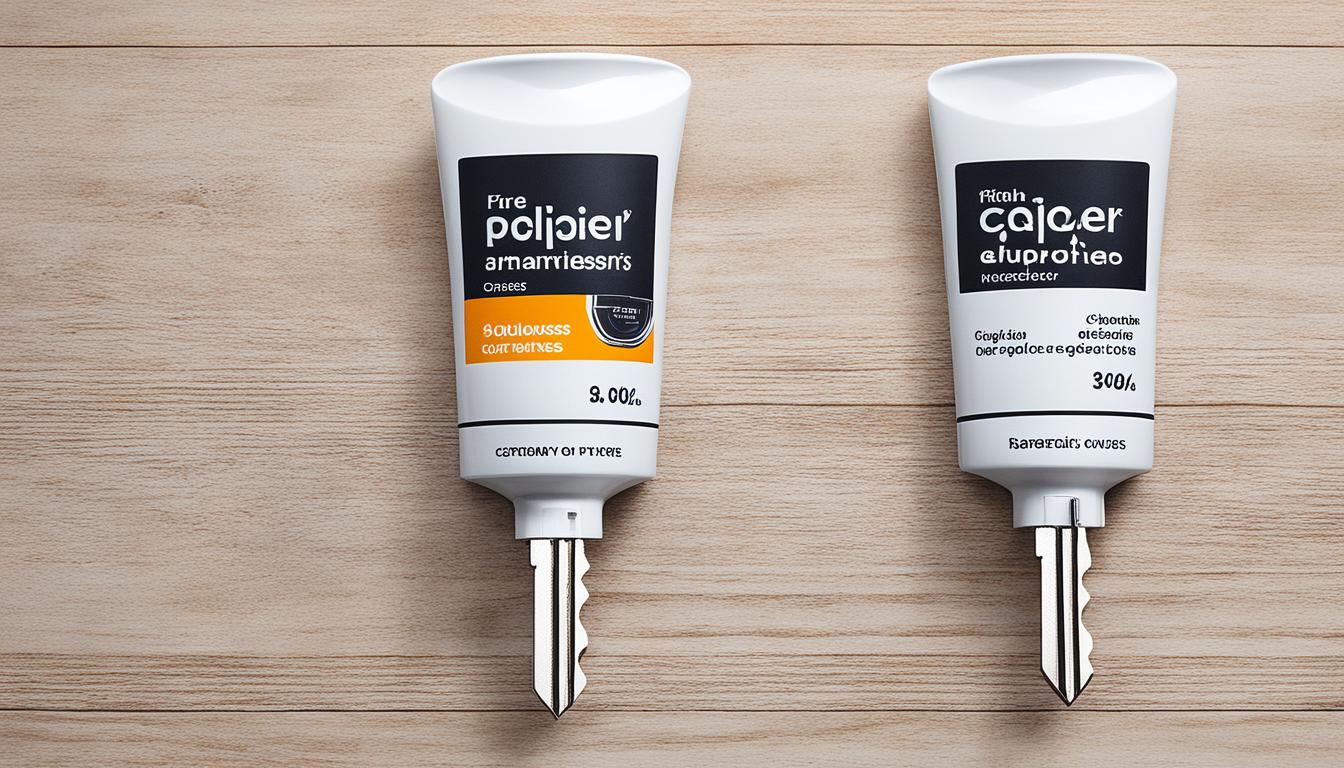APV stands for Adjusted Present Value. It’s a vital tool in affiliate marketing. It evaluates the worth of an affiliate program.
APV looks at things like how much money affiliates get on average. It also examines the whole value of the affiliate program. This gives a full picture of how profitable the program could be.
Key Takeaways:
- APV is a financial tool used in affiliate marketing to evaluate the value of an affiliate program.
- It considers factors such as average payout value and program valuation.
- APV helps affiliates assess the profitability and potential of their programs.
- Understanding APV can lead to strategies that optimize revenue and program value.
- APV is essential for affiliates looking to maximize their earnings in the competitive affiliate marketing industry.
Understanding APV in Affiliate Marketing
APV, short for Adjusted Present Value, is key in affiliate marketing. It helps affiliates judge a program’s value and its profit-making potential. By focusing on APV, affiliates work to make the program more valuable.
APV measures the worth of an affiliate program. It considers average payouts and uses certain strategies to boost revenue. These moves help increase the program’s APV.
To raise APV, focus on getting a bigger average payout. This might mean talking with advertisers for better commissions, pushing expensive products, or choosing programs with better commission setups.
Growing affiliate revenue also plays a big part in boosting APV. Affiliates can tailor their marketing, use customer data smartly, and improve their way of converting visits to sales. These strategies help make more money.
All these efforts together can really lift an affiliate program’s APV. This leads to more income and success in affiliate marketing.
| Benefits | Strategies |
|---|---|
| Increased earnings | 1. Negotiate higher commission rates 2. Promote high-ticket products 3. Select affiliate programs with favorable commission structures |
| Long-term success | 1. Targeted marketing 2. Leverage customer data 3. Implement conversion rate optimization techniques |
Calculating APV Metrics in Affiliate Marketing
To figure out how well an affiliate program is doing, we look at APV metrics. APV, or Adjusted Present Value, examines several parts to deeply understand a program’s results. This includes checking the average payout, revenue, and how the program is performing overall. With this info, affiliates can work out the APV. Then, they can improve their program.
Factors Considered in APV Calculation
When we calculate APV, we look at a few important things that affect an affiliate program. These include:
- Average Payout Value: This is how much affiliates make for each conversion. A bigger average payout means a better program.
- Revenue: This shows how much money the program is making. It tells us if the program is doing well financially.
- Performance Metrics: We also look at how well things like conversion rates and click-through rates are doing. This helps us see if the program is effective and profitable.
Looking at these things gives affiliates a clear picture of their program’s health. It helps them see where they can do better.
Visualizing APV Metrics
| Factors | Metrics |
|---|---|
| Average Payout Value | High |
| Revenue | $500,000 |
| Click-through Rate | 5% |
| Conversion Rate | 10% |
The table above shows the APV metrics clearly. A high average payout and good revenue mean the program is profitable. Good click-through and conversion rates also boost the program’s APV.
The image above shows what the APV metrics look like. It highlights why these factors are key in affiliate marketing.
By figuring out APV metrics and checking performance closely, affiliates can make smart choices. This helps them improve their program’s profit, increase revenue, and succeed in affiliate marketing.
Strategies to Increase APV in Affiliate Marketing
To boost APV in affiliate marketing, there are several tactics affiliates can use. They help in optimizing revenue, improving average payout value, and boosting the program’s overall worth.
1. Optimize Revenue
Improving APV begins with focusing on revenue optimization. To do this, affiliates can:
- Identify high-converting products or offers
- Optimize landing pages and call-to-action buttons
- Implement effective email marketing campaigns
2. Maximize Average Payout Value
Raising the average payout value is also key. Affiliates can achieve this by:
- Promoting more expensive products or services
- Using upselling or cross-selling to boost order size
- Negotiating for better commission rates with advertisers
3. Implement Growth Strategies
To enhance their program’s value, affiliates can use growth strategies. These may include:
- Increasing audience reach via content marketing or ads on social media
- Collaborating with related affiliate programs
- Exploring new networks or platforms for affiliates
Using these strategies helps affiliates to improve their APV. It allows them to increase their earnings and succeed in affiliate marketing long-term.
Benchmarks for APV in Affiliate Marketing
Affiliates are key in driving revenue and adding value to an affiliate program. To check an affiliate program’s performance, they can use benchmarks for Adjusted Present Value (APV). These benchmarks show best practices and how to increase program value.
The Importance of APV Benchmarks
APV benchmarks let affiliates see how well their program performs against others. By comparing APV metrics to these benchmarks, affiliates can spot improvement areas. They can then boost their program’s profitability.
Key APV Metrics to Benchmark
When looking at APV benchmarks, affiliates should consider these important metrics:
- Average Payout Value: This is what an affiliate earns for each referral. Comparing this to benchmarks helps affiliates know if their payouts are competitive.
- Affiliate Program Valuation: This measures a program’s value, considering revenue, growth, and competition. Comparing this to benchmarks, affiliates can see how well they’re doing.
- Conversion Rate: This is the percentage of visitors who complete an action, like buying something. Checking conversion rates against benchmarks helps find ways to get more conversions.
- Return on Investment (ROI): ROI shows how profitable an affiliate program is. Affiliates compare this to benchmarks to see if their marketing is working well.
Implementing APV Best Practices
To make the most of APV, affiliates should follow these steps:
- Keep track of APV metrics to know where to improve.
- Be aware of industry changes and adjust strategies when needed.
- Work with merchants and peers to learn and share tips.
- Always test and tweak marketing campaigns for better conversions and more revenue.
Using APV benchmarks and following best practices help affiliates grow their revenue and make their program more valuable. It’s important to stay active and adjust to changes in affiliate marketing to succeed long-term.
Importance of AOV in Affiliate Marketing
Average order value (AOV) is key in affiliate marketing because it affects the adjusted present value (APV). It’s the average amount customers spend in transactions through affiliate marketing. By raising AOV, affiliates can greatly increase their earnings and make their program more valuable.
Increasing AOV can lead to higher profits. It means each purchase brings in more money, maximizing marketing returns. This results in higher commissions and boosts the affiliate program’s financial health.
Raising the AOV also impacts the APV of an affiliate program positively. The APV looks at financial elements like average payout value and overall valuation. A higher AOV makes the program more appealing to potential partners and investors.
Strategies to Increase AOV
Affiliates have several strategies they can use to grow AOV and better the APV of their program:
- Cross-Selling and Upselling: Showing customers related or better products can make them spend more, which ups the AOV.
- Bundling Products: Selling items in bundles at a discount gets customers to buy more, lifting the AOV.
- Implementing Volume Discounts: Giving discounts based on how much a customer buys encourages more purchases, raising AOV.
- Offering Free Shipping Thresholds: A minimum amount for free shipping motivates adding more to the cart, pushing up AOV.
- Personalizing Recommendations: Suggesting extra products based on what customers like can prompt more buying, increasing AOV.
By using these tactics in their marketing, affiliates can indeed boost AOV. This results in greater revenue and better performance of their program.
| Benefits of Increasing AOV | Strategies to Increase AOV |
|---|---|
| 1. Higher profits | 1. Cross-selling and upselling |
| 2. Enhanced APV of the affiliate program | 2. Bundling products |
| 3. Implementing volume discounts | |
| 4. Offering free shipping thresholds | |
| 5. Personalizing recommendations |
Leveraging LTV in Affiliate Marketing
Lifetime value (LTV) is vital in affiliate marketing. It helps figure out the total value and profit of a program. By using LTV growth strategies, affiliates can boost the value of customers over time. This also improves the Adjusted Present Value (APV) of their programs.
Why is LTV important?
LTV shows the total money a customer brings in throughout their relationship. It considers order value, repeat buys, and loyalty. Focusing on LTV helps affiliates create lasting bonds with customers. This leads to more money and a valuable program.
LTV growth strategies for affiliate marketing
There are strategies to raise LTV and APV in affiliate programs:
- 1. Provide exceptional customer experience: Great service and personalized experiences boost customer happiness and loyalty. This leads to more repeat purchases.
- 2. Implement retention and loyalty programs: Rewards and perks for existing customers make them shop more. This boosts their lifetime value.
- 3. Upselling and cross-selling: Suggesting related products can raise order values and overall LTV.
- 4. Build customer trust: Being transparent and reliable increases trust. This encourages long-term relationships and higher LTV.
- 5. Personalize marketing efforts: Customized marketing impacts buying choices. It can increase a customer’s value over time.
Using these strategies, affiliates can see better revenue short-term. And they build a lasting, profitable program long-term.
By focusing on LTV growth, affiliates boost loyalty and revenue. This improves the lifetime value of customers. In turn, it makes the APV of their program better. Remember, lasting customer relationships are crucial for long-term success.
CPA vs. RevShare in Affiliate Marketing
In affiliate marketing, affiliates meet two common commission ways: cost per action (CPA) and revenue share. Each approach impacts the value of an affiliate program differently. Both have unique traits.
CPA means affiliates get a set amount for each action the referred customer completes. This could be buying something or signing up. With CPA, affiliates know how much they’ll earn each time, making income steady.
Revenue share works differently. Here, affiliates earn based on the customer’s spending. They get a cut of the sales. This means if the customer keeps buying, affiliates could make more money over time.
Choosing between CPA and revenue share matters a lot for affiliates. It affects how much they can earn. They should look at the affiliate program, who they’re targeting, and if customers might buy again. This helps affiliates pick the right commission model.
The best choice – CPA or revenue share – depends on what’s being promoted and the customers’ value. Affiliates should try different models to see what’s most profitable. There’s no universal answer.
Affiliates aim to boost their earnings and the value of the affiliate program. By understanding CPA and revenue share, they can pick the best strategy. This helps them earn more.
Below, see a table comparing CPA and revenue share. It shows differences and things to think about:
| Commission Model | Key Features | Pros | Cons |
|---|---|---|---|
| Cost per action (CPA) | Fixed payment for predetermined actions |
|
|
| Revenue share | Percentage of revenue generated by referred customer |
|
|
When affiliates weigh the pros and cons of each model, they can choose wisely. This helps them set up a commission structure that meets their goals.
Tracking Links and Conversion Rates in Affiliate Marketing
In affiliate marketing, tracking links are key. They help affiliates measure their campaign success and analyze conversion rates. Affiliates can use these insights to improve their strategies.
These links have a unique identifier for each marketing tool, like banners or emails. When someone clicks and makes a purchase or signs up, the link tracks it. This way, the affiliate knows their effort paid off.
Tracking links give detailed analytics, like click-through and conversion rates. This data helps affiliates see which campaigns work best. They can then focus on the most successful ones.
To boost conversion rates, affiliates should try different tactics. Testing different ads and landing pages can show what works best. Making sign-up or buying easy also helps increase conversions.
Tracking Link Metrics
| Metric | Definition |
|---|---|
| Click-through Rate (CTR) | The percentage of users who click on a tracking link out of the total number of users who view it. |
| Conversion Rate | The percentage of users who complete a desired action, such as a purchase or lead submission, out of the total number of users who click on a tracking link. |
| Earnings per Click (EPC) | The average earnings generated per click on a tracking link. |
By monitoring these metrics, affiliates can spot weak campaigns. They might tweak ad placements or rethink the offer. This helps improve performance.
Tracking links also show which traffic sources work best. By knowing this, affiliates can spend wisely. Investing more in successful channels boosts conversion rates and earnings.
For affiliate marketing success, tracking links and optimizing conversion rates are essential. This approach helps affiliates earn more and grow their programs.
The Role of CTR and ROAS in Affiliate Marketing
In affiliate marketing, knowing about CTR and ROAS is key for APV improvement. CTR shows the ad click percentage, while ROAS reveals the revenue from advertising spend.
Enhancing CTR and ROAS boosts revenue and the value of an affiliate program. Higher CTR draws more visitors, increasing sales. Better ROAS ensures efficient ad budget use.
Boosting CTR involves making ads that speak to the audience. Ads should focus on the audience’s interests and needs. Adding catchy visuals and clear calls-to-action can also attract more clicks.
To improve ROAS, monitor ad performance and adjust campaigns. This requires analyzing data to make informed choices. Tools for affiliate marketers offer insights for better ROAS.
Affiliates must understand their audience and refine ads. Enhancing CTR and ROAS raises an affiliate program’s value and revenue. It leads to a higher APV.
| CTR | ROAS |
|---|---|
| Measures the percentage of clicks generated by an ad | Calculates the revenue generated in relation to the amount spent on advertising |
| Indicates the effectiveness of ad copies, targeting, and relevancy | Helps in optimizing advertising budget and maximizing revenue |
| Higher CTR can lead to increased conversions and sales | Improved ROAS ensures effective utilization of ad spend |
| Creating compelling ad copies and utilizing targeted keywords can boost CTR | Analyzing campaign performance and making data-driven decisions can optimize ROAS |
Strategies to Increase Average Order Value (AOV) in Affiliate Marketing
Affiliates are vital to an affiliate marketing program’s success. To improve the average order value (AOV) and the program’s value, they can use several strategies. By doing so, they can increase their earnings and the program’s overall worth.
1. Upselling
Upselling is a powerful way to raise AOV. It means suggesting higher-priced items or related products to customers. Affiliates can show customers the benefits of these additional products. This encourages them to spend more, thus lifting the average order value.
2. Bundling
Bundling is another method to increase AOV. It combines related products or services into one package at a discount. This gives customers more value and encourages them to spend more. Affiliates should promote these bundles to raise the average order value.
3. Offering Personalized Plans
Personalization is essential in affiliate marketing. It can also boost AOV. Affiliates can offer custom plans based on customer preferences. This makes customers feel special and more likely to choose higher-priced options. It results in a higher average order value.
Using these strategies can greatly help an affiliate marketing program. They increase the AOV, boosting earnings and making the program more beneficial. Affiliates should focus on these methods to enhance their success.
Conclusion
APV is a key concept in affiliate marketing. It helps affiliates gauge the value and profitability of a program. By using APV and applying strategies to boost revenue and average order value, affiliates can improve their success.



